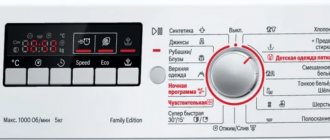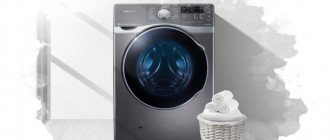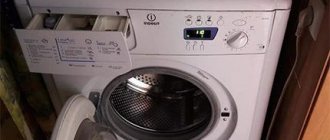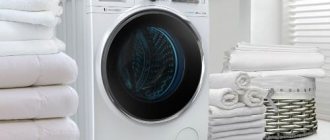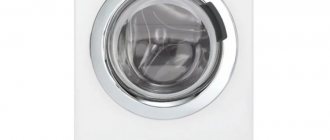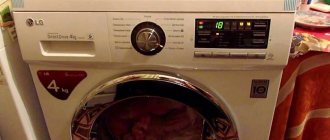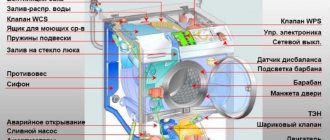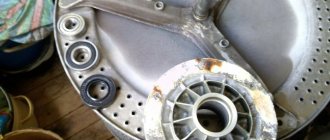Why do you need an oil seal?
This is a round seal. Material: rubber. Its function is to seal the gaps between moving and non-moving parts. In an automatic washing machine (AWA), a sealing rubber ring is necessary to prevent leaks in the tank. Drum bearings are parts that protect against moisture. It is the seal that protects them from water.
To ensure tightness, a rubber ring, placed on the shaft and inserted into the bearing, is attached with maximum density - this prevents water from flowing out through the joint gaps. Rotation of the metal bushing with the seal attached to it leads to increased wear of the rubber. To slow down wear, you need a special water-repellent lubricant.
How to replace lubricant: is it worth using automotive types?
An oil seal (or, as it is more correctly called, an oil seal device) is a part of a mechanism that serves as a sealing element between its two parts, one of which is movable and the other is not. The seal is usually made of rubber, so it not only seals, but also seals the connection.
In a washing machine, oil seals are needed to protect the bearings from water ingress. They are located on top of a bronze bushing, which, in turn, is fixed along the axle shaft. The seals must be replaced along with the bearings so that the connection always remains tight and airtight.
The axle shaft is a rotating shaft on which the tank and drum of the washing machine are attached. While rotating, the shaft comes into contact with the inner surface of the oil seal. Constantly exposed to friction, this part wears out quickly. To slow down this process, a special lubricant is used for the oil seals, which ensures sliding, thereby reducing friction.
Sometimes it is not possible to find a special lubricant for oil seals. In this case, craftsmen replace it with similar oil-based products, for example, grease or lithol. Experts warn against using these products, as they contribute to rapid wear of the seals. Such lubricants are used in the automotive industry, but they cause more harm than good to household appliances.
Lubricant for washing machine oil seals increases the service life of bearings Very often, the need to replace or lubricate the oil seal arises due to frequent washing at high temperatures. If greasy oil stains appear on freshly washed laundry, you need to think about lubricating the part for further operation of the unit. It is possible that you will need to install a new oil seal or bearing in the washing machine.
The oil seal is a small part in a washing machine that plays a very important role. It protects the moving parts of the washing machine from water that spins in the drum during washing. Thanks to the seal, water cannot enter the electronic parts from the tank. The oil seal is put on a special bushing and fits tightly to the outer part of the drum.
Oil seals are a sealing material, which is also called a rubber shaped seal.
Typically, the seal is made of durable rubber to perform the sealing function, and it also connects the fixed and moving parts of the automatic washing machine.
The oil seal, also known as the cuff, can be made of different rubber - silicone rubber, fluorine rubber or nitrile-butadiene material. This part is constantly subject to friction and very often its wear causes malfunction of the washing machine.
To extend the service life of the oil seal, you need to constantly lubricate it so that it does not dry out. When the rubber seal dries out, water can enter the bearing and cause serious damage.
It is quite difficult to understand that the oil seal is being rubbed. A washing machine sound specialist can determine this malfunction. It is better to replace the oil seal at a service center, but you can install it at the client’s home - in this case you will have to disassemble half of the unit.
The process of lubricating the bearings and oil seal of a washing machine pump is not difficult in itself. The difficulty is how to get to them. In order to replace or lubricate these parts, you need to see them.
The grease on the oil seal must not be washed away with water during operation.
Most often, before they fail, bearings begin to knock. In any case, a change in the sound of a running machine indicates that it would not hurt to check it, lubricate it, clean it, etc.
First you need to determine whether the oil seal and bearings need lubrication or whether they should be replaced. If bearings are replaced with original parts from the manufacturer's factory, for example, Indesit, this option is the most acceptable. But if the bearings are fake or not of very good quality, then it is better to lubricate them additionally, even if they are new. Cheap quality lubricant leads to rapid wear, so it is better not to skimp on it.
READ MORE: How to choose lamps for the bathroom: lighting features and options for using the best lamp models (105 photo video)
So, you've reached the right part. Lubricating the oil seal is as easy as shelling pears - you need to apply an even, thick layer of lubricant to the inner ring, where the oil seal comes into contact with the shaft. After lubrication, carefully put the oil seal back in place.
Please note that there is no need to push the lubricant anywhere else!
Before installing the bearing, it should be cleaned. To lubricate the bearing, you need to remove the protective cover from it with a scalpel or knife and fill the entire space with lubricant. If the bearing is non-separable, it is more difficult to lubricate it, but nevertheless possible. The goal is to create pressure and force the lubricant into narrow crevices.
After lubricating the bearing and oil seal, your task is to correctly reassemble the entire machine in reverse order.
In some cases, it is not possible to find a special lubricant for oil seals and then you have to use materials with similar characteristics. Some craftsmen have adapted to lubricate oil seals with grease or lithol - both of these products are petroleum-based. In fact, these lubricants can be used to treat car bearings and other parts, but they are not suitable for a washing machine.
Experts consider silicone-based lubricant to be good - it has decent water resistance and meets all the necessary requirements
Washing machine repair specialists assure that the use of such products will only harm the parts of automatic machines.
Such lubricants are not designed for use in such units. They are not resistant to detergents - gel or washing powder, fabric softener, etc. Powders and gels dissolve fat, which means they will quickly wash lithol from the oil seal and bearing space. Lubricant washed out by water is the key to drying out the rubber cuff.
Automotive lubricants will not last long, no more than 2 years, as knowledgeable people say, and the parts will have to be re-lubricated. It is also a big risk to use lubricants that are not designed to lubricate the rubber seal. Incorrect or poor-quality lubrication can cause wear of the oil seal and failure of the washing unit.
Which oil seal lubricant to choose is a question that should be taken seriously. If you purchase a low-quality lubricant or forget to lubricate the oil seal altogether, then replacing the bearings and oil seal cannot be avoided.
Many parts come into contact with water during operation, so they need high-quality protection against moisture penetration
Lubricant for this type of part has a number of requirements that should not be neglected:
- Moisture resistance - the lubricant must be water-repellent, since this determines how quickly the lubricant is washed out and water seeps into the bearing;
- Heat resistance - the washing machine heats the water, which means the lubricant must have an acceptable temperature range without losing its properties;
- Viscosity - the lubricant must be thick enough so that it does not spread even after prolonged use;
- Softness - the lubricant should not be aggressive and should not affect rubber and plastic parts.
All lubricants that meet these requirements are not cheap. You can buy them in specialized stores that sell parts for household appliances or in washing machine repair services.
The best option would be to find a service that sells lubricant in disposable syringes. The dosage is calculated with a reserve, and the price will definitely be less than when buying a whole tube.
Washing machine manufacturers sometimes produce their own lubricant for their brand. The composition may vary, but generally this lubricant is suitable for any type of oil seal. For example, the Indesit company produces Anderol lubricant of excellent quality. Viscous and hydrophobic lubricant Anderol is sold in 100 ml jars, but you can also find small syringes for two doses of lubricant.
If you decide to save money, you can purchase analogs of the original lubricant or silicone and titanium lubricant, but be sure to make sure that it meets all the requirements described above.
To lubricate oil seals, waterproof silicone grease Grasso is often used, which has good properties and fully satisfies all requirements. Liqui Moly (Silicon-fett) also has excellent characteristics. This is a thick lubricant made in Germany that does not lose its properties at temperatures from -40 to 200 C° and is not washed off with water.
You can disassemble the washing machine to lubricate the parts yourself, but if the product is under warranty, it is better to contact the service center for professional help. In addition, the service center provides a certain guarantee for the replacement and lubrication of the bearing and oil seal. If you do the repairs yourself, it is very important to choose the right lubricant for the washing machine oil seal and strictly follow all the rules for servicing the parts.
The washing machine, despite the manufacturers’ striving for perfection, tends to break down. Among the most common failures is bearing wear. If this happens, complex and expensive repairs are inevitable. Many users with the appropriate skills change bearings themselves. When replacing, you have to lubricate the rubber seal - the bearing seal. Let's figure out how to lubricate the tank seal of a washing machine, why it is needed and how to change it.
The process is similar to replacing bearings:
- The washing machine is disconnected from the power supply. The water is drained.
- They are sorting out the SM. To change the tank seal of a washing machine, you have to disassemble almost the entire device. Remove the top cover, then the front and back panels.
- The drive belt is removed from the drum. It is necessary to prevent the pulley from moving; to do this, it is stopped with a hammer. Unscrew the bolt located in the center of the pulley. Remove the pulley.
- Disconnect the wiring. Most often it is secured using plastic clamps - remove them with wire cutters. After the wiring is disconnected, remove the engine. The wires from the heating element are also disconnected.
- Unscrew the bolts and remove the upper counterweight. Take out containers for the powder. Unscrew the fasteners holding the control panel and remove it.
- Disconnect the fill valve by loosening the clamp. Take out the container for the powder and the valve along with it - having first unscrewed the wiring and mounting bolts.
- Take out the pressure switch hose attached to the tank. Open the hatch door and, bending the seal, remove the clamp. The cuff is tucked inward. Unscrew the lock and unfasten the wiring.
- Unscrew the fastening joints and remove the counterweights. Unscrew the shock-absorbing elements and remove the tank from the hooks. They get him. That's it, the main thing is done - the tank is removed. All that remains is to find out how to get the old rubber ring out and how to install a new one.
- Unscrew the screws securing the tank. Using a screwdriver, release the latch mechanism and remove the cover. They hit the bushing to remove the drum.
- Pry up the seal using a screwdriver and remove it.
- accelerated wear of the rubber part;
- water leaks;
- corrosion of the bearing assembly due to moisture leaks;
- wear and installation of new bearings.
READ MORE: White Decembrist 20 photos of varieties with white flowers Schlumbergera rules of care at home
What are the requirements?
Sunflower or other household oil is not suitable here. The substance used to lubricate the sealing ring has special requirements.
- High moisture resistance. Otherwise it will quickly wash out.
- No aggression towards rubber - it should not corrode or soften. By choosing the wrong substance, you will shorten the life of the seal.
- Heat resistance. Due to the friction of the shaft and the operation of the bearing unit, the rubber heats up. Hot water should also not affect the properties of the sealing element.
- Sufficient thickness. Liquid consistency is not suitable - it will leak out after some time.
A little about the oil seal and how to lubricate it
The oil seal is the part located between the moving and stationary parts of the LG washing machine. As a rule, this is a rubber element. The part is made from this material because the first one is designed to seal and seal the connecting parts of the device.
The bearings are located next to the oil seal. The former protect the bearings from liquid getting into them. Oil seals are subject to periodic replacement, as are bearings. It is then that the articulated part of the washing machine will be airtight and tight.
The drum of the LG device is fixed to the axle shaft. When the shaft element rotates, it contacts the oil seal. And where there is rotation, there is constant friction. That is why the oil seal and bearings may soon become unusable. And to prevent this from happening, many use a product such as silicone grease for washing machine oil seals and grease for washing machine bearings. When treated with lubricant, the parts begin to glide better and rub against each other less. And if you do not use lubricant for the seals and bearings, the parts will dry out and get wet, and, as a result, the bearing and the entire washer will break.
How to lubricate the oil seal?
Contact specialized stores for lubricants. Specify why you are taking them, and the seller will suggest a suitable option. But keep in mind that such a product is not cheap, as it is highly specialized.
Anderol for washing machines
Lubricant made in Italy. Chemically neutral. Excellent moisture resistance. Maximum operating temperature: + 190 degrees. Not afraid of heating. For any seals.
Amblygon - lubricant for oil seals
This is another Italian version. Works at the same temperatures as Anderol. Repels water, not aggressive. Packaged in syringes with a capacity of 2 ml, as well as in 100 gram tubes.
Litol-24 and 24 M
A universal product - suitable for different purposes. When heated, it does not become harder or stronger. High stability in mechanical and chemical terms. Range: minus 40 – plus 120 degrees. Properties of modification 24M - no compaction in an aqueous environment, mechanically stable, can be combined with other lubricating compounds.
What lubricant to use for the washing machine oil seal
An oil seal is a rubber sealing ring that is necessary to seal the gaps between static and moving parts.
In our case, the oil seal is a rubber ring that prevents water from flowing out from the washing machine tank through the gaps between the tank and the shaft. As you can see from the photo above, the oil seal is inserted onto the bearings, and inside has a hole for the shaft. As you already understood, when rotating, the shaft constantly rubs against the walls of the oil seal, thereby wearing it out. Therefore, the seal must be well lubricated to last longer.
If you changed the bearing and forgot to lubricate the oil seal, which is unacceptable, then you may experience the following problems: the oil seal will wear out very quickly, it will not last long, working “dry”, after which it will begin to leak water. Water will enter the bearings, which will also begin to rust very quickly, and their frictional force will increase.
You can buy special lubricant in specialized stores that sell spare parts for washing machines. If you tell the seller why you need lubricant, then he will probably give you a suitable tube without any questions. The only problem is that such a lubricant will be expensive, since it is believed that it is specially designed for this purpose.
Of course, you can try to save money and find cheaper analogues. Silicone grease is considered a good lubricant for oil seals; it meets all requirements, and most importantly, has good moisture resistance.
When purchasing silicone grease, pay attention that it is moisture- and heat-resistant, and also thick. Usually these parameters are indicated on the tubes: moisture resistant, operating temperature limits.
One excellent silicone oil seal lubricant is LIQUI MOLY “Silicon-Fett”, which meets all requirements. Of course, it is not cheap either, but its quality is high. You can safely lubricate the oil seal in the washing machine with it. Its operating temperature ranges from -40°C to 200°C.
You should not skimp on lubrication: you do not need to lubricate the oil seal with lubricants such as Litol, Tsiatim, Azmol and others. When using these lubricants, your washing machine will start squeaking very quickly and you will have to change the bearings again. Believe me, it will be much more expensive to change the bearings again than to spend money now on good lubrication.
You have changed the bearings and now you need to insert the oil seal, but before that you need to lubricate it. To do this, take the lubricant and apply it along the outer contour of the oil seal in a thin layer, spreading it evenly. After this, insert the oil seal into the niche in the tank. Next, lubricate the oil seal along the internal contour.
All! This completes the oil seal lubrication. Now you can continue assembling the washing machine.
A washing machine is usually purchased with the expectation that it will last at least ten years, but this does not always happen. The service life of a washing machine depends on many factors: the integrity of the manufacturer, frequency of use and compliance with operating rules.
Careful care includes not only the selection of high-quality laundry detergents, timely cleaning and prevention of scale formation, but also monitoring the condition of the internal elements of the washing machine.
One of these elements is the oil seal. You can find out what it is and how to keep it in working order by reading this article.
After replacement, the sealing device requires mandatory treatment. The ideal option is a waterproof lubricant for washing machine seals. It is purchased in specialized stores that sell components for repairing household appliances. In addition to water resistance, lubricant for oil seals for washing machines must have the following characteristics:
- It should not contain chemicals that can corrode rubber or soften it (as a rule, sealing parts are made from this material). A lubricant that is not suitable in its composition will not perform its intended functions, but will only reduce the service life of the oil seal.
- Increased heat resistance. The specificity of the oil seal is such that when the washing machine is operating, it comes into contact with the shaft, and during friction and exposure to hot water, the temperature of the parts rises. Therefore, the composition that will soften sliding must withstand rising temperatures. High-quality lubricant for oil seals for washing machines can withstand temperatures up to 180 - 200 degrees.
- Thick composition. This is an important indicator of good lubrication. Because during operation the liquid solution will simply flow out.
If the owner of household appliances carries out repairs with his own hands, and he has a question about which lubricant for the washing machine oil seal is better, then you need to choose it according to the above criteria, and not according to the manufacturer. In any case, in any normal specialized store, sellers will advise the required composition; you just need to explain its purpose.
The best option would be to use those substances that were recommended by the manufacturer of the washing machine. Many manufacturers produce branded lubricants, which, according to them, are suitable specifically for one or another model of household appliances. But in fact, these are standard compounds that are suitable for any oil seal. Unfortunately, not everyone can afford even such lubricants, since this pleasure is not cheap.
As alternative good options, you can choose the following types of lubricants intended for machine maintenance:
- "Litol-24".
- "Ciatim-221".
- Azmol-Alumina.
- Ambligon.
Of course, there are many similar options, but the above listed compositions have already been tested more than once on a wide variety of models of washing machines and have shown good results during use.
Nowadays there is a large selection of lubricants on the market and any table of spare parts for washing machines also includes its availability. There are specially designed options, but the point is that you won’t need a whole package to carry out the repair yourself, and it will cost a lot.
READ MORE: Stools for the kitchen 77 photos, folding modern stools and with a back, white round and other models in the interior
Packages usually contain 50-100 grams of material, and with lubrication you will need 1-2 grams.
Here are some of them :
- Huskey Lube-o-Sela lubricant (100 g - packaging);
- Hydra lubricant (100 g).
If there is no original lubricant, the washing machine oil seal can be lubricated with others, the main thing is that they meet the requirements of their future operation.
At home, you can lubricate the seal of a washing machine with the following lubricants:
- Litol (or Litol-24). It has chemical and mechanical stability in the temperature range from 40 to 120 degrees Celsius.
- Cyatim 221. Performs well in high friction units and does not change its basic properties at temperatures up to 150 degrees.
Also many automotive and other solid lubricants, of which there are a huge number today, including silicone analogues of washing machine oil seals.
The process of processing the bearings and oil seal does not take as much time as the process of disassembling the washing unit itself will take. In order to get to the oil seal, you will need to disassemble all or most of the machine, remove and disassemble the tank, and in some cases, cut it.
But at the first signs of oil seal wear, it is better not to delay replacing it. Moreover, this will still have to be done soon, but if you delay it, the repairs will become more difficult and require a much larger budget. Many washing machines do not require complete disassembly; you just need to remove the rear inspection window, dismantle the hub and carry out the process of replacing and lubricating the parts.
For example, a large number of vertical models are equipped with removable hubs on the outside of the tank. Replacing them does not take much time, but they cost quite a lot. And in vertical machines there are two of them, on different sides of the product, which usually has two covers for removing the necessary components, which makes your work easier.
It is precisely in this case that it is necessary to lubricate the necessary parts in a timely manner in order to increase their service life. Installing the washing machine oil seal when replacing bearings is a mandatory procedure that requires special attention. After removing the old rubber and worn-out bearings, it is necessary to thoroughly clean and lubricate the hub before installing new parts.
You should also pay attention to the quality of the powders used when washing and do not abuse high temperatures, especially since this does not have a very favorable effect on the quality and durability of the items being washed.
Composition and properties of silicone lubricants
Why are silicone lubricants used for rubber seals? The answer is simple - other materials based on essential and mineral oils are most often incompatible with elastomers and cause them to swell or shrink.
Synthetic lubricants (for example, based on PAO oils) have a smaller operating temperature range and service life.
Silicone lubricants have:
- Compatible with elastomers and plastics
- Operable over a wide temperature range
- Anti-friction and anti-wear properties
- Sealing properties
- Excellent release properties
- Resistant to water and environmental influences
The majority of the composition of silicone lubricants (up to 100%, like EFELE UNI-S Spray) is silicone. It is usually supplemented with extreme pressure additives, corrosion and oxidation inhibitors, solid lubricant particles (such as PTFE) and other components that improve the performance of the lubricant.
Self-lubrication of parts
Oil seal lubrication is carried out according to the same principle as bearing lubrication. To get to it you will need to completely disassemble the washing machine:
- unscrew the lid (top of the machine);
- disassemble the front and back parts of the wall;
- remove the tank and disassemble it into two parts;
- After this you can remove the oil seal.
If the seal and bearings are damaged, you will need to buy new parts and replace them. If the bearings are in order, then you just need to lubricate them. But first, clean off the dirt. To do this, you can take Anderol lubricant. This is done like this: remove the protective cap from the disassembled bearing and squeeze out the lubricant inside. If the bearing has been replaced with a new one, then it is not necessary to lubricate it with Anderol.
Things are completely different with the oil seals; they need to be lubricated in any case. Anderol waterproof seal lubricant is squeezed out in an even layer onto the inner race that contacts the bushing. After completing these procedures, the first thing to do is install the bearing in place, followed by the oil seal. The remaining parts are assembled in reverse order.
Below we offer a video that describes in detail the replacement and lubrication of the oil seal. Detailed instructions can also be found on the form.
Despite the fact that the washing machine is constantly in contact with water, there are parts in it that should not get wet. To a large extent, this applies to drum bearings, which quickly wear out when the lubricant is washed out. The bearing is protected from water penetration by an oil seal - a hermetic seal.
Some users are wondering: do I need to lubricate the washing machine oil seal? Let's figure it out.
Benefits of silicone lubricants
Based on the above, the following advantages of silicone lubricants can be identified:
- High adhesion to various substrates
- Compatible with elastomers, plastics, varnishes, paints and other materials
- Biological inertia
- Antistatic and dielectric properties
- Elasticity
- Oxidation resistance
- Resistance to weak solutions of acids and alkalis
- Resistant to washing off with water
- Non-flammability
- Long service life
- Lack of smell, taste and color
- Wide operating temperature range (average values: -50 to +200 °C)
- Anti-friction properties
- Good heat transfer
We make a replacement
Let's figure out how to get to the oil seal. Here are the step by step steps.
- After disconnecting the machine from the network and communications, drain the remaining water from the drain filter. It is located under the front panel, behind a small hatch.
- Remove two screws from the back to remove the top panel. Now unscrew the screws around the perimeter of the back panel and set it aside.
- Remove the drive belt from the drum. Using the hammer handle to lock the pulley, unscrew its central bolt and remove it from the tank.
- Disconnect any wiring that may be attached to the drum. It is usually secured with plastic clamps, so use wire cutters.
- After disconnecting the motor wiring, unscrew the fastening bolts and pull the electric motor out of the housing. Also unfasten the wires from the heating element.
- Remove the tank top counterweight bolts. Put it aside.
- Pull out the detergent dispenser by pressing the central latch. Remove all bolts that hold the control panel in place. Unlock the plastic latches, remove it and place it on top of the case.
- Loosen the filler valve clamp and disconnect it from the tank. Pull out the powder hopper along with the filling valve. To do this, unfasten the wires from the valve and unscrew the mounting bolts from the back.
- Remove the pressure switch hose, which is usually attached to the tank.
- Open the hatch door, bending the sealing rubber, remove the outer clamp. Tuck the cuff inside the tank. Unscrew the screws of the UBL lock, placing your hand behind the SMA body, pull out the lock and unfasten the wiring.
- Unscrew the screws around the perimeter of the front panel, pull it up and set it aside.
- Remove the counterweights from the tank by unscrewing the bolts.
- After unscrewing the shock absorbers, remove the tank from the hooks and pull it out.
You have completed the removal of the tank. Now let’s figure out how to properly remove and install the oil seal in the washing machine.
- Remove the screws around the perimeter of the tank. Using a screwdriver, release the latches and remove the top half.
- By hitting the bushing several times, knock the drum out of the tank.
- Remove the oil seal by prying it with a screwdriver.
Before installing the oil seal correctly, apply lubricant. Begin to lubricate the outer surface with a thin layer. After installing the seal in place, use a syringe to apply lubricant to the inner surface.
You understand how to change and lubricate the oil seal. All that remains is to assemble the machine and enjoy its smooth operation. A video on the topic will help you:
